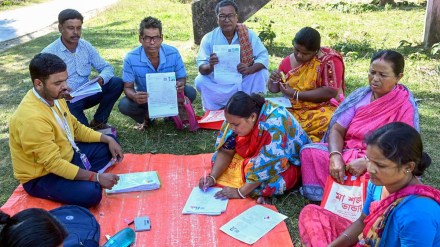The state of West Bengal has seen a 66 per cent increase in the number of registered voters between 2002 and 2025, reveals data of the Election Commission of India (ECI). The Special Intensive Revision (SIR) exercise of the ECI has revealed that the number of voters in 23 years has grown from 4.58 crore to 7.63 crore. When the review of the electoral roll was last done in 2002, Bengal had 18 districts. Later, more districts were formed and the number reached 23.
According to a report in Indian Express, out of the top ten districts with the highest increase in the number of voters, nine border Bangladesh. BJP says it is a proof of their “Muslim infiltrators” claim. But the ruling Trinamool Congress (TMC) says it indicates the inflow from across the border of Hindu refugees escaping persecution.
One of these districts has recorded a voter increase of 105%, the report added. Nine districts bordering Bangladesh are:
- Uttar Dinajpur (105.49%)
- Malda (94.58%)
- Murshidabad (87.65%)
- South-24 Parganas (83.30%)
- Jalpaiguri (82.3%)
- Cooch Behar (76.52%)
- North-24 Parganas (72.18%)
- Nadia (71.46%)
- Dakshin Dinajpur (70.94%)
The one district which does not border Bangladesh is Birbhum, which has seen a voter increase by 73.44%.
Why such a increase in 2 decades? TMC, BJP weigh in
TMC spokesperson Arup Chakraborty told the Indian Express that the sharp rise is due to Hindu refugees who have come from Bangladesh and settled in the border districts.
“The Hindu population in Bangladesh dropped from 23% (in 1951) to 8% (in 2022). They have not gone to China. Apart from small sections going to Assam and Tripura, the majority have come to West Bengal,” he claimed.
Rejecting BJP’s Muslim infiltration narrative, Arun said, “Such people have settled in Cooch Behar, Alipurduar and Bangaon, where the BJP has won with their votes… In Malda and Murshidabad, there is a sizable Muslim population, and we have won seats. However, our Chief Minister, Mamata Banerjee, does not believe in such religious divisions and is demanding protection for all.”
Senior BJP leader and former state president Rahul Sinha meanwhile called the numbers an “alarming trend”. He said the party has been saying this for years, and it’s now being reflected in data.
“Seven districts bordering Bangladesh are in an alarming condition, and many are expected to become or will become Muslim-majority districts due to infiltration,” he added, quoted IE. He went on and allege that this infiltration and creation of hubs is being planned.
On the other hand, CPI(M) state president and Politburo member, Md Salim, opined that the BSF should have checked this. “A sizable number of Hindu refugees also came in with others; that’s why the Hindu population declined in the neighbouring country,” he told the IE.
Bengal SIR and protests
Protests have been held by TMC leaders against the ongoing exercise in the state. West Bengal Chief Minister Mamata Banerjee this week aslo wrote to Chief Election Commissioner (CEC) Gyanesh Kumar, urging him to halt the exercise. She claimed the entire process has reached a “dangerous” stage, with moutning pressure on the booth level workers.
The TMC recently shared a post narrating the case of an individual who has to prove his identify after living for years in the state.
“A man who has lived his entire life in India now finds himself forced to audit his own existence. This is the absurdity and the cruelty wrought by the SIR panic that Bangla birodhi Zamindars have unleashed across Bengal,” the party said.
“In Belgharia, this manufactured fear took a devastating turn. Ashok Sardar, a man in his sixties, attempted suicide after discovering that his and his wife’s names were missing from the 2002 voter list. Days of anxiety and uncertainty drove him to the brink. This is not just an isolated tragedy. How many more innocent lives must be shaken before @BJP4India and
@ECISVEEP confront the human cost of their reckless actions?” the party added.
Bengal is watching and when the people speak, their verdict will be unequivocal, it concluded.
